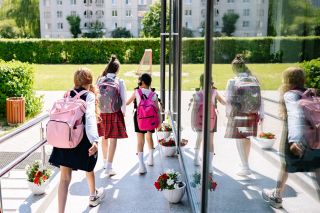Child Development
Has a Decline in Playtime Affected Children’s Mental Health?
Mental health problems in kids are on the rise. Is a lack of playtime to blame?
Posted November 6, 2023 Reviewed by Michelle Quirk
Key points
- Increases in childhood mental health problems have been steady over the past several decades.
- Increases in children’s anxiety and depression may be partly due to decreased independent playtime.
- More “play” among adults may be helpful as well.
If you’re an adult of a certain age, you probably have lots of stories that start with “When I was a kid.” Although we all had different experiences growing up, what usually follows those words is something that would be considered inappropriate by today’s parenting standards, like, “When I was a kid, I was allowed to ride my bike in the street without a helmet,” or “When I was a kid, the TV was my babysitter,” or “When I was a kid, we didn’t have car seats.”

These were all true for me as a child of the 1980s. During that era, most of my friends’ parents smoked Marlboro cigarettes in the house, I frequently rode the city bus to the mall with my elementary school friends, and no one (not even parents) wore a seatbelt. As a parent of two myself now, I can tell you firsthand that things have changed. While everyone walked to school in the 1980s, there are rules now about when kids are allowed to walk by themselves, stay home alone, or even sit in a parked car. Most of these new rules are in the interest of children’s physical safety. But although no one is suggesting we go back to the days of no car seats, many of these new restrictions have made scientists wonder whether they have any downstream effects on children’s mental health.
Rise in Mental Health Issues Among Children
One new paper published in the Journal of Pediatrics argues that there are. In the paper, researchers propose that the rise in mental health problems that have been documented in children over the last several decades is directly related to restricting their autonomy and, in effect, how much they can play by themselves. In other words, researchers are making the claim that increases in children’s anxiety and depression are due (at least in part) to the decrease in children’s independent playtime, without the supervision of an adult (Gray et al., 2023).
First, it’s important to note that mental health problems in children are indeed on the rise. The authors of the Journal of Pediatrics article cite a statement issued in 2021 to the Biden administration from the American Academy of Pediatrics, the American Academy of Child and Adolescent Psychiatry, and the Children’s Hospital Association, calling mental health in children a national emergency. Research suggests that this increase in childhood mental health problems has been steady over the past several decades. The researchers also report that over the last half-century, the percentage of children who meet clinical criteria for anxiety or depressive disorders has increased by five to eight times. The rates of suicide have also risen among young people, with a 3.5-fold increase between 1950 and 2005 and another 2.4-fold increase just between 2005 and 2020.
So children are more anxious and depressed than ever. But is this mental health crisis because children play less on their own? Play is certainly on the decline. Parents report that their children play outside far less than they did, and children are far less likely to walk to school with their friends (instead of their parents) than in previous years (Gray et al., 2023). One study shows that between the years 1981 and 1997, unstructured playtime dropped by about 25 percent (Hofferth & Sandberg, 2001), and a more recent survey of nearly 9,000 families with preschool-aged children in the United States indicated that about half do not go outside to play regularly (Tandon, Zhou, & Christakis, 2012).
This is happening for a number of reasons. Children are spending more time in structured activities in schools and daycares (Hofferth & Sandberg, 2001), and, as a result, recess time is decreasing. In fact, a survey of US schools suggests that only 40 percent of schools have a designated policy for outdoor play (Burriss & Burriss, 2011). Furthermore, children are spending more time on screens, often saying that they prefer electronic games to playing outside (Dowdell, Gray, & Malone, 2011). Parents are also working more, and there are usually more concerns about safety when it comes to playing outside versus inside where kids don’t have to be monitored as much. This is a particular concern for families living in high-poverty areas who may be especially nervous for their children’s safety (Kimbro & Schachter, 2011).
Other Factors Affecting Children's Mental Health
It's important to note that although there is a relationship (or what researchers and statisticians call a correlation) between a decrease in independent playtime and an increase in children’s mental health problems, it doesn’t necessarily mean that one causes the other. Further, while a decrease in independent play can certainly be one factor that affects mental health and well-being, it is likely not the only factor (which the authors of the original study admit). For example, mental health problems in adults have also skyrocketed. No one knows exactly why we are experiencing this increase, but a decrease in social interactions could be one factor, especially given the rise in social media use, and the onset of the COVID-19 pandemic, which left people isolated for long periods of time. Indeed, loneliness is becoming widespread in the United States, with up to 60 percent of Americans reporting feeling lonely on a regular basis (Holt-Lunstad et al., 2010). And one of the biggest predictors of mental health problems in children is mental health problems in parents. So it’s likely that parents’ own mental health is affecting their children’s.
Whatever the cause, the numbers don’t lie—mental health problems are on the rise, for everyone. The question is, what do we do about it? The implication of the research presented here is that independent play, particularly with friends, could be helpful for children’s mental health. And, likewise, perhaps some “play” among adults would be useful as well. This is especially true for parents, as getting out once in a while for some adult leisure time might not only help parents’ mental health, but it might also trickle down to support their children’s well-being. It likely won’t solve our mental health crisis completely, but it’s a place to start.
References
Burriss, K., & Burriss, L. (2011). Outdoor play and learning: Policy and practice. International Journal of Education Policy and Leadership, 6(8), 1–12.
Dowdell, K., Gray, T., & Malone, K. (2011). Nature and its influence on children’s outdoor play. Journal of Outdoor and Environmental Education, 15(2), 24–35.
Gray, P., Lancy, D. F., & Bjorklund, D. F. (2023). Decline in Independent Activity as a Cause of Decline in Children’s Mental Well-being: Summary of the Evidence. The Journal of Pediatrics, 260.
Hofferth, S. L., & Sandberg, J. F. (2001). Changes in American children's time, 1981–1997. Advances in Life Course Research, 6, 193–229.
Holt-Lunstad, J., Smith, T. B., & Layton, J. B. (2010). Social relationships and mortality risk: a meta-analytic review. PLoS medicine, 7(7), e1000316.
Kimbro, R. T., & Schachter, A. (2011). Neighborhood poverty and maternal fears of children's outdoor play. Family Relations, 60(4), 461–475.
Tandon, P. S., Zhou, C., & Christakis, D. A. (2012). Frequency of parent-supervised outdoor play of US preschool-aged children. Archives of Pediatrics & Adolescent Medicine, 166(8), 707–712.


